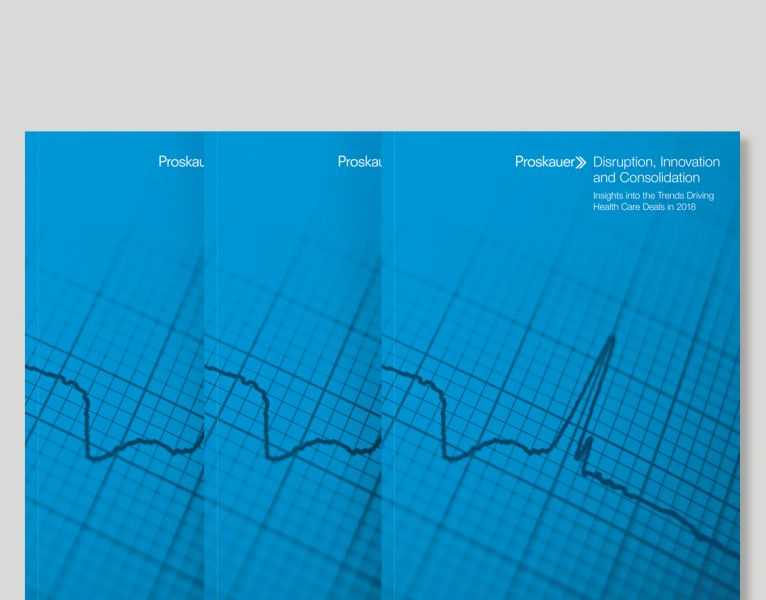The Growth of Private Credit in a Growing Industry
As the U.S. population ages, the demand for and cost of medical services have grown exponentially. The extraordinary growth in U.S. health care spending that has resulted is well documented and, naturally, investors looking to capitalize on this growth story have followed suit, pouring enormous sums of debt and equity capital into health care businesses of all kinds.
In 2017, national health care spending totaled $3.5 trillion or 17.9% of the country’s gross domestic product. The Centers for Medicare and Medicaid Services (CMS) estimate this figure will grow at an average rate of 5.5% reaching nearly $6 trillion annually by 2027.
According to Pitchbook, during the last five years, nearly $3 trillion of capital has been invested in health care businesses at a rate of more than 7,000 transactions each year. Data maintained by Proskauer’s Private Credit Group confirms that non-bank direct lenders have fueled this broader market trend, both in terms of deal volume and the amount of capital deployed.
Indeed, since 2016, more than one in five private credit transactions handled by the Proskauer Private Credit Group involved health care borrowers, injecting nearly $115 billion of debt capital into health care businesses of all kinds. While default rates on these loans—like others— have remained low, private credit lenders must be sensitive to the unique characteristics of health care loans and how those qualities manifest themselves when a borrower experiences financial or operational stress.
In this article, we examine some of the unique challenges faced by private credit providers when restructuring health care loans, and strategies that can be implemented to maximize a lender’s recovery. When it comes to health care loan restructurings, there is no “one size fits all” solution. On the contrary, restructuring strategies for troubled health care companies are inherently bespoke.
The Unique Challenges Faced by Healthcare Lenders
Experienced lenders understand that financing a businesses in a heavily regulated industry like health care presents a variety of challenges that do not exist in other market sectors.
- Structural Challenges – In the last 10 years, an extraordinary amount of debt capital has been loaned to physician and dental practice groups. To comply with state law requirements limiting the delivery of medical care to licensed practitioners (so-called corporate practice of medicine statutes), private credit loans are typically made to a management service organization or “MSO” that owns many of the assets needed to conduct a medical or dental practice, including contracts with third party payors, accounts receivable, medical equipment and office leases. The MSO may also employ non-clinical staff. The MSO’s assets are then pledged as collateral to secure the loan. The primary challenge presented by this structure is obvious: although a lender may have perfected liens against the assets of a MSO, this collateral package has limited value without the licenses or healthcare professionals needed to operate the business as a going concern. As a result of these (and other) obstacles, when a default occurs on a loan to physician or dental practice group, foreclosure is a remedy with limited utility.
- Regulatory Challenges – The health care industry is regulated heavily at both the state and federal level. Compliance with a constantly changing labyrinth of health care laws and regulations is labor intensive, expensive and fraught with risk. Additionally, the ability to participate in the multi-billion dollar Medicare system is a key asset for most health care borrowers and their lenders. Because Medicare reimbursements are such an important source of revenue for healthcare businesses, the threat of suspension and recoupment are extremely powerful levers that the government actively employs to ensure regulatory compliance. Statutory limitations on pledging Medicare receivables presents yet another layer of difficulty for the lender. These risks surrounding Medicare participation are perhaps the most daunting challenge affecting healthcare lenders as they apply to practice groups and non-practice groups alike.
- Challenging Liabilities – For a financially troubled company that needs to restructure its balance sheet, all liabilities are challenging. But for health care companies, certain types of liabilities are more acute than others. In particular, Medicare overpayments, and liabilities arising under the False Claims Act, Stark and Anti-Kickback statutes pose truly unique threats to healthcare businesses and private credit lenders. These liabilities can be difficult to identify during the underwriting process, yet can materialize and escalate quickly. From simple billing errors to overzealous marketing schemes, debts in this category can trigger a suspension of Medicare reimbursements and throw an otherwise profitable healthcare business into crisis, leaving lenders with little or no time to react. Even though such liabilities may be unsecured and structurally subordinate to the rights of a secured lender, the combination of government recoupment rights and the potential for non-dischargeability in bankruptcy makes these debts far more potent in a loan workout scenario than other types of debt. An even more pernicious liability may arise from whistleblower or “qui tam” lawsuits which are filed under seal and without notice to the borrower (or its lenders). These lawsuits often portend a lengthy and expensive civil or criminal investigation followed by an equally time consuming and expensive settlement and remediation process.
In this installment of our discussion of health care loan restructurings, we will examine the regulatory and liability challenges identified above, and how each affects the strategic options available to a direct lender. In a subsequent piece, we will more closely analyze the structural challenges and potential solutions for restructuring loans to physician and dental practices.
Overcoming the Challenges
One of the most common obstacles faced in health care loan restructurings stems from the borrower’s inability to transfer or monetize its relationship with Medicare, particularly when the borrower has exposure for Medicare overpayments or other liabilities arising from non-compliance with applicable healthcare laws.
In an out-of-court setting, CMS aggressively enforces its rights, in particular the right to recoup overpayments or suspend Medicare reimbursements where False Claims Act and other violations of law are suspected. In bankruptcy, CMS is equally aggressive, insisting that borrowers may only “assume and assign” rights to participate in Medicare—frequently referred to as a “Medicare provider agreement”—under Bankruptcy Code provisions governing executory contracts.
To do so, a borrower or a purchaser of its business must cure all existing defaults and assume full responsibility for all known and unknown liabilities, including liabilities for False Claims Act, Stark and Anti-Kickback violations. Faced with this “all or nothing” dilemma, financial investors will have no interest in acquiring the borrower’s business and, therefore, the strategic options available to a lender may be limited to a fire sale of the borrower’s assets to a strategic purchaser. Two recent bankruptcy court decisions, however, may have dramatically changed the landscape.
In separate decisions handed down in September, bankruptcy judges in California and Delaware rejected these conventional notions about Medicare participation, concluding that a debtor’s “participation agreement” is not an executory contract.
Rather, both courts held that Medicare participation is a statutory entitlement that a debtor/borrower may sell, like other assets, free and clear of pre-existing liabilities, including claims of overpayment by CMS. While the precise contours of these rulings remain to be developed in future cases, if upheld on appeal, lenders may have a powerful new tool to work with that was previously unavailable to them in a healthcare setting—a credit bid in bankruptcy.
The ability to deploy new capital to fund a corporate turnaround as a means of maximizing existing loan recoveries is one of several attributes that sets a private credit provider apart from a traditional lender. In the health care context, if a borrower’s right to participate in the Medicare system is an asset that can be encumbered and sold like other assets, free and clear of preexisting liabilities, then direct lenders will no longer be relegated to accepting the net proceeds from fire sales to a strategic bidder in a hastily organized sale process.
On the contrary, lenders may now be able to avoid the triple threat posed by (i) the right of CMS to suspend, withhold or recoup Medicare payments, (ii) the inability of a borrower to discharge False Claims Act liability under a Chapter 11 plan, and (iii) the ability of CMS to impose “successor liability” as a condition of any sale by a troubled healthcare company.
In a world where Medicare provider entitlements may be encumbered and sold free and clear of pre-existing debts, direct lenders can structure and finance a sale process that will be open to financial purchasers and where a reserve price is effectively set. Absent purchase offers at price levels that the lender believes are achievable immediately or in the future following a turnaround effort by the borrower, the lender can credit bid its debt, acquire the borrower’s business and implement a turnaround plan as the owner of a company with a restructured balance sheet.
Although this strategy is routinely pursued in other industries, it has previously been unavailable to health care lenders.
Private Credit Restructuring
For every challenge posed by a defaulted health care loan, there is a value maximizing strategy available to mitigate or avoid loan losses. Of course, successful strategies must be carefully tailored to the unique circumstances of the situation, taking into account the whole range of legal, economic and factual variables including the borrower’s market segment, capital structure, available liquidity, regulatory threats and other exigencies.
Reproduced with permission. Published Dec., 24, 2019 Copyright 2019 The Bureau of National Affairs, Inc. 800-372- 1033. For further use, please visit http://www.bna.com/copyright-permission-request/






